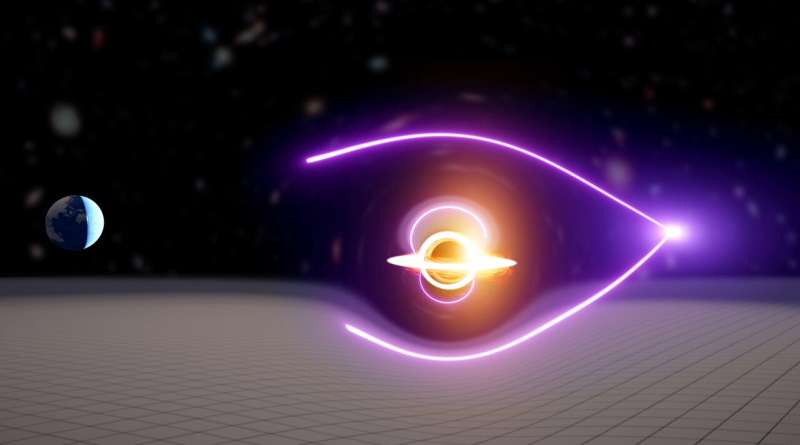Collected at: https://phys.org/news/2021-03-black-hole-seeds-key-galaxies.html?utm_source=nwletter&utm_medium=email&utm_campaign=weekly-nwletter

A new black hole breaks the record—not for being the smallest or the biggest—but for being right in the middle.
The recently discovered ‘Goldilocks’ black hole is part of a missing link between two populations of black holes: small black holes made from stars and supermassive giants in the nucleus of most galaxies.
In a joint effort, researchers from the University of Melbourne and Monash University have uncovered a black hole approximately 55,000 times the mass of the sun, a fabled “intermediate-mass” black hole.
The discovery was published today in the paper Evidence for an intermediate mass black hole from a gravitationally lensed gamma-ray burst in the journal Nature Astronomy.
Lead author and University of Melbourne Ph.D. student, James Paynter, said the latest discovery sheds new light on how supermassive black holes form. “While we know that these supermassive black holes lurk in the cores of most, if not all galaxies, we don’t understand how these behemoths are able to grow so large within the age of the Universe,” he said.
The new black hole was found through the detection of a gravitationally lensed gamma-ray burst.
The gamma-ray burst, a half-second flash of high-energy light emitted by a pair of merging stars, was observed to have a tell-tale ‘echo’. This echo is caused by the intervening intermediate-mass black hole, which bends the path of the light on its way to Earth, so that astronomers see the same flash twice.
Powerful software developed to detect black holes from gravitational waves was adapted to establish that the two flashes are images of the same object.
“This newly discovered black hole could be an ancient relic—a primordial black hole—created in the early Universe before the first stars and galaxies formed,” said study co-author, Professor Eric Thrane from the Monash University School of Physics and Astronomy and Chief Investigator for the ARC Centre of Excellence for Gravitational Wave Discovery (OzGrav).
“These early black holes may be the seeds of the supermassive black holes that live in the hearts of galaxies today.”
Paper co-author, gravitational lensing pioneer, Professor Rachel Webster from the University of Melbourne, said the findings have the potential to help scientists make even greater strides.
“Using this new black hole candidate, we can estimate the total number of these objects in the Universe. We predicted that this might be possible 30 years ago, and it is exciting to have discovered a strong example.”
The researchers estimate that some 46,000 intermediate mass black holes are in the vicinity of our Milky Way galaxy.
More information: Evidence for an intermediate-mass black hole from a gravitationally lensed gamma-ray burst, Nature Astronomy (2021). DOI: 10.1038/s41550-021-01307-1
Journal information:Nature Astronomy
Provided by University of Melbourne
